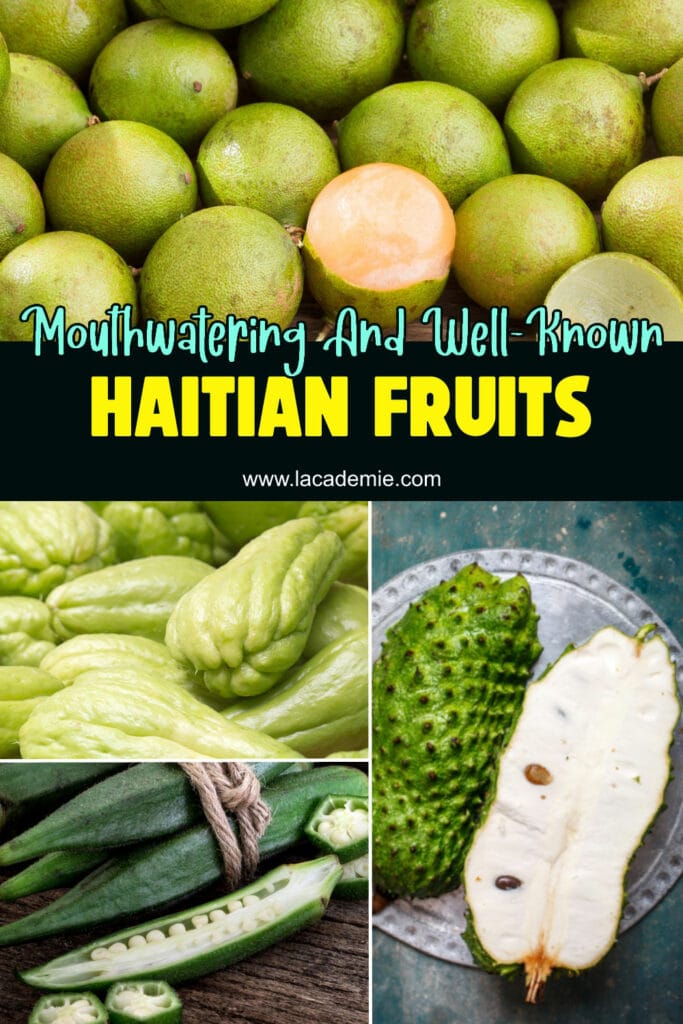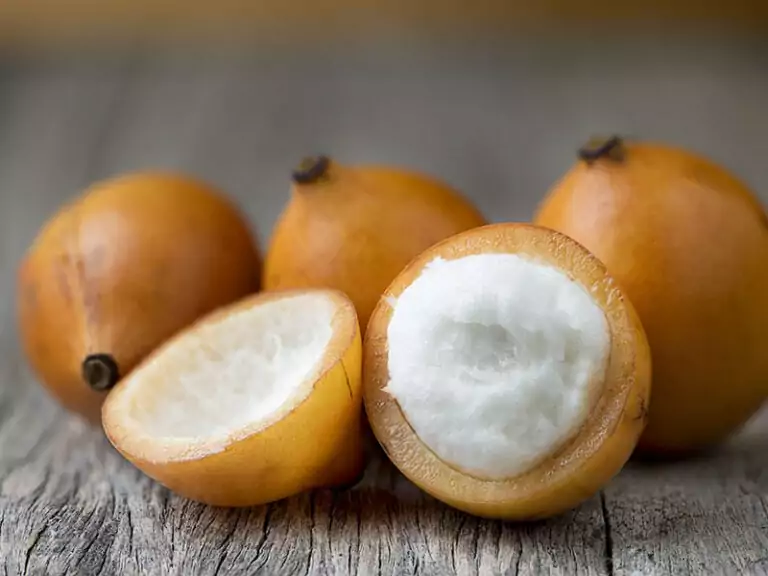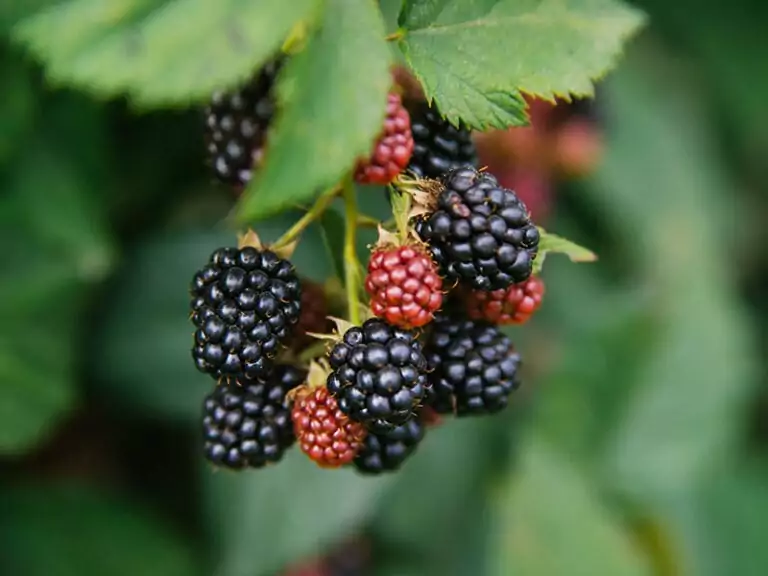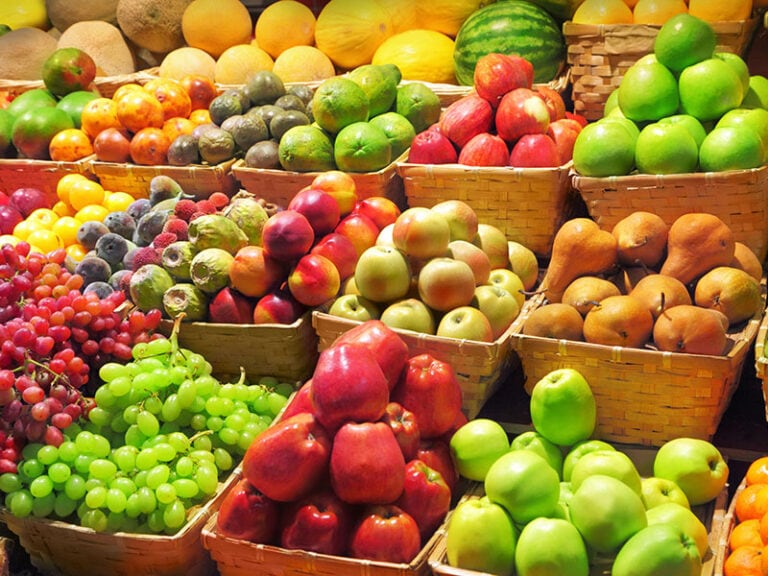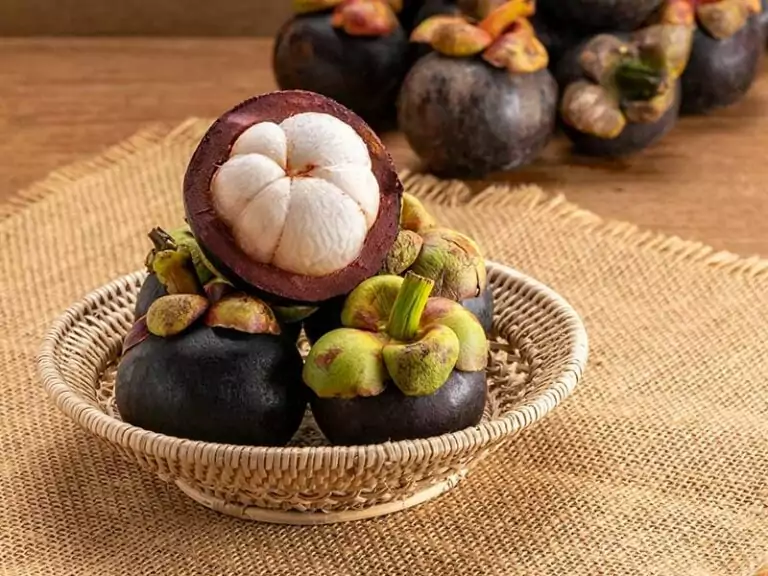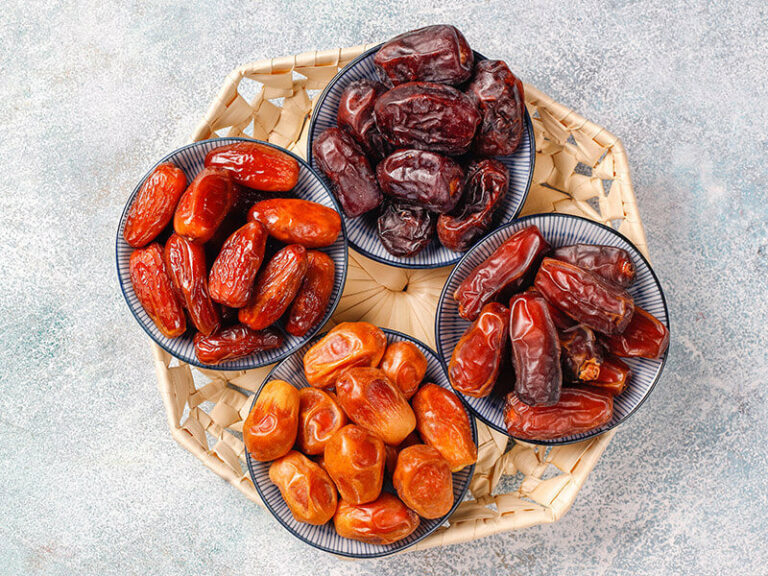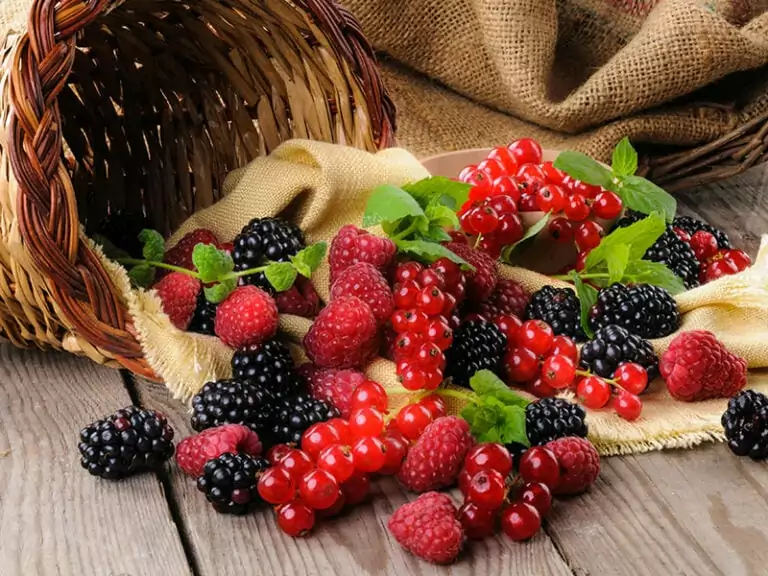Haitian fruits always appear in the daily meal of people in this country. Eating fruits is the fastest way to refresh your palate after a party. The freshness and incredible taste of them will make you flutter right away.
This article will introduce a list of fantastic Haitian fruits you should refer to to get the most exciting tour of this nation. It is time to know more exotic and unique fruits worldwide. Do not neglect any moment since you can miss essential information.
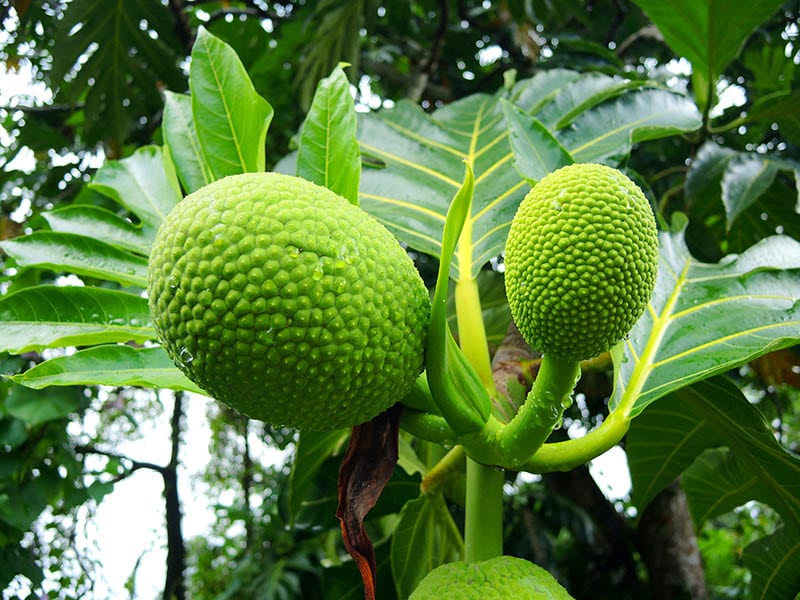
Delicious Haitian Fruits Containing Only One Seed
Haitian fruits are diverse, from seeded types to seedless ones. This section will introduce a list of wonderful Haitian fruits that contain one seed. Let’s explore right now.
1. Guinep – Mamoncillo
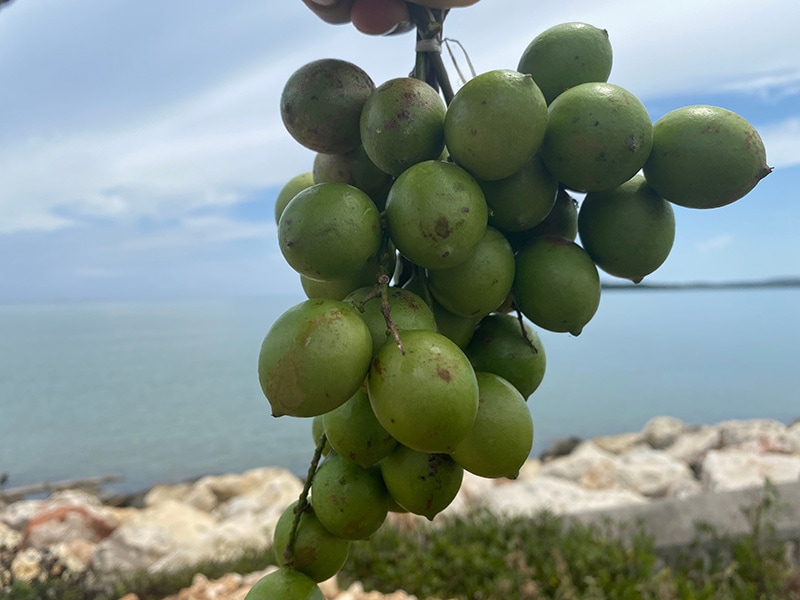
Guinep is an excellent type of fruit you must taste when coming to Haiti. This fruit is a popular choice for tourists in the summer. It originates in Central and South America, the Caribbean, and other regions of the Old World tropics.
This fruit has existed in Haiti and the Caribbean since pre-Columbian times. Incredibly, there is a National Genep Fruit Festival in Puerto Rico. In many regions, people often call it genip, bajan ackee, Chenet, or mamoncillo.
Guinep is a delicious fruit with thin skin, succulent flesh, and a pit in the center. You can recognize this fruit due to its green skin. You will love the orange and gelatinous pulp of guinep.
Besides the enchanting sweetness, you can feel a bit of bitter taste from this fruit. It can remind you of the taste of wine. Please remember to discard the whitish seed. People often add it to Haitian drinks or alcoholic beverages.
Furthermore, you can eat raw guinep to enjoy its authentic and natural flavor. Haitians also prepare canned guinep to diversify the choices for their party.
Nutrients: Carbs, fiber, calcium, phosphorus, and vitamin C.
Season: It is common in Haiti from June to August.
How to eat: Break its skin with your finger. Consume the succulent flesh around the seed.
Explore all the fantastic things about the outstanding guinep.
2. Mango
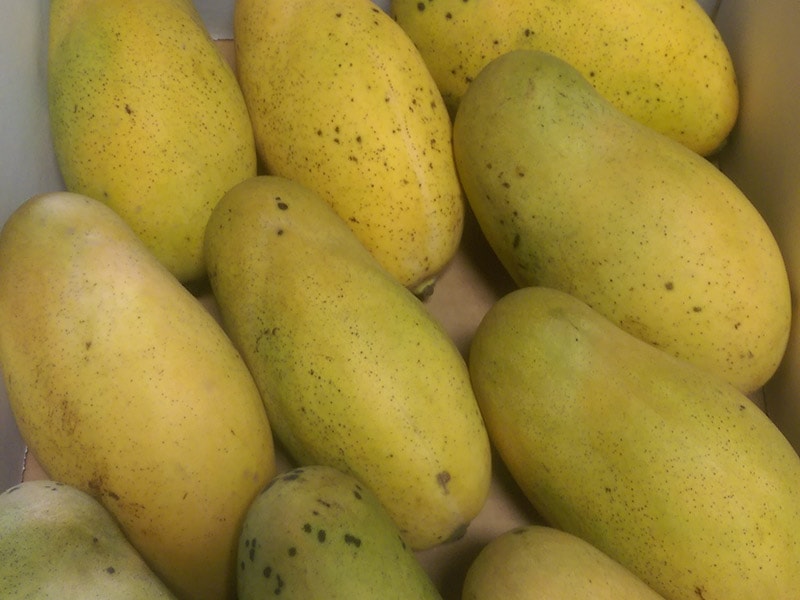
Mango is always a common choice in cuisine. Although it is native to Myanmar, Northeastern India, and Bangladesh, you can find it easily at many local markets in Haiti. This fruit was grown in ancient times in many Asian countries.
This fruit will have various colors, sizes, and shapes, depending on the variety. In Haiti, you will have the chance to try about 12 different types of mango. In particular, 10 departments of this country will have their mango types due to the differences in weather.
Typically, young mango is often green in color and has a crunchy texture. It will become soft and creamy when mature. You will be captivated by ripe mango’s eye-catching red, orange, or yellow color.
You will catch this fruit in oval, round, or kidney shapes. When you eat unripe mango, its flavor is similar to tart lime. The sweetness of ripe mango will fascinate you right away. Besides, the sour taste will create a distinctive feature of this fruit.
The soft texture of ripe mango is suitable for making ice cream, pie, smoothies, and juice. In addition, you can cut the mango into small pieces to eat as a fresh dessert. The unripe version is used commonly in cooking.
Nutrients: Rich in calories, fiber, vitamin A, C, and potassium.
Season: It is available all year round, but the peak season is in March.
How to eat: You just need to peel the skin and eat the delicious flesh around the seed. Slice around the pit and cut many lines on the flesh, and push it up from the skin to eat.
3. Cashew
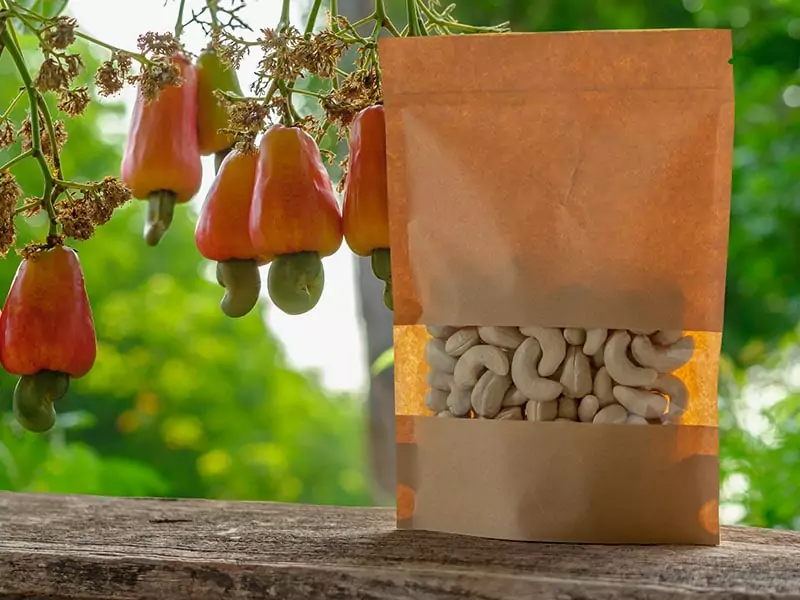
Cashew is a famous fruit in tropical and subtropical regions worldwide. This fruit has a unique structure when the nut is out of the fruit. Its seed is a commercial product in many countries globally.
Cashew is derived from Southeastern Venezuela and Northeastern Brazil. Gradually, it is cultivated widely in Haiti and many nations in Central America, the Caribbean, and Asia. Ivory Coast and India are the two leading producers of cashew worldwide.
This fruit has a gorgeous appearance and eye-catching bright yellow or reddish hues. You can confuse a cashew apple with a pear because of the similarities in shape and color. The skin of its seed includes anacardic acid and phenolic resin.
People love to add sweet and juicy cashew flesh to fruit drinks and liquor. Furthermore, in Haiti, you can feel its taste in curries, sauces, ground, or sweet desserts. Let’s roast its seeds to prepare an attractive snack.
Nutrients: It includes calories, carbs, fiber, protein, calcium, and iron.
Season: The season extends from June to December.
How to eat: To eat its flesh, you will slice it into 2 parts and use a spoon to scoop the flesh. You can roast its seeds to eat as a snack. To reduce its astringent taste, you should steam it, rinse it with cold water, and steep it with salt before eating.
Discover the reasons leading to the high price of cashew.
4. Avocado – Zaboca
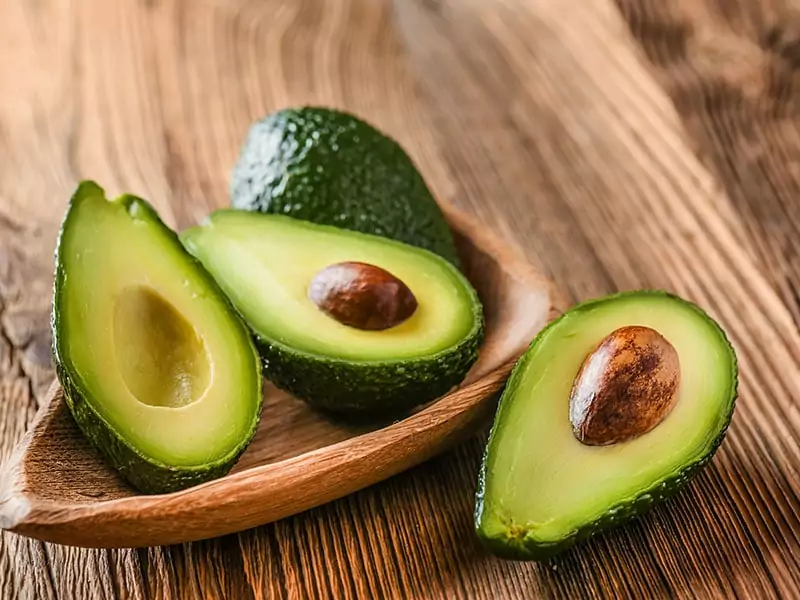
Avocado is a versatile fruit as you can create many delicious recipes from it. This fruit is derived from America. Avocados are famous in Haiti, central Mexico, Guatemala, and other tropical regions worldwide.
This delicious fruit contains 3 parts: a thin green, black, or brown skin, buttery flesh, and an ample seed in the center. The shape of the avocado will remind of the pear and egg shapes. It will turn from a firm texture to softness when mature.
Typically, people often pick avocado from the tree before it is ripe. Its flesh has a distinctive aroma and pale green or yellow colors. It is a mixture of flavors with the appearance of grassy, nutty, and earthy tastes. Let’s enjoy your breakfast with avocado, cassava, and bread.
There are many different types of avocado in Haiti and around the world. This fruit’s subtle and delicate flavor will be perfect for making smoothies or vegetarian foods. In addition, Haitians love to enjoy the authentic taste of avocado in salads or dips.
Nutrients: Plenty of calories, carbs, fiber, vitamin C, B5, magnesium, and potassium.
Season: It is available from June to November in Haiti.
How to eat: Dice the fruit into 2 sections and remove the giant pit in the center. Get the flesh with a spoon to eat.
5. Chayote – Militon
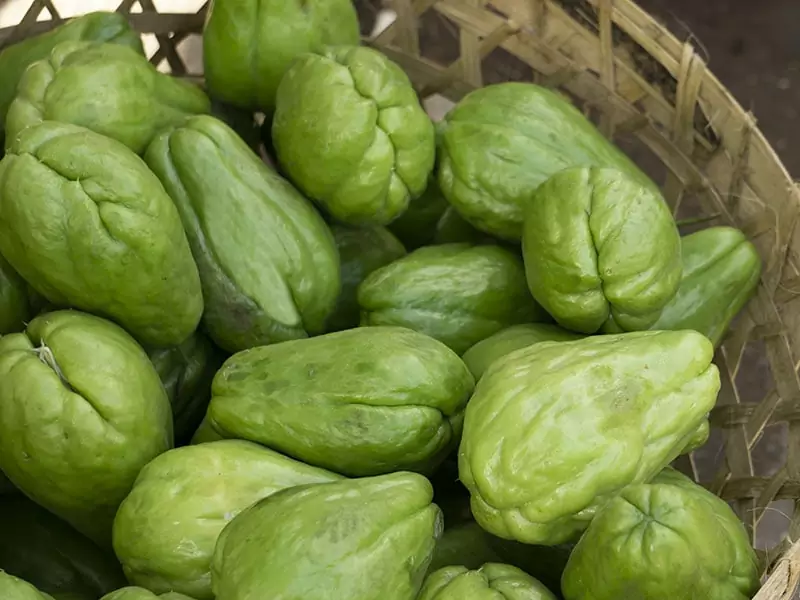
Chayote is a part of the Cucurbitaceae family. This fruit is native to Mexico, Honduras, Guatemala, and Latin America. Many people think that chayote is a vegetable, but it is a fruit.
It has the same shape as a pear. This fruit’s waxy, wrinkled, and green skin will captivate you immediately. You can see its flesh in green or white shades. When slicing this fruit into 2 halves, a large pit will appear.
Because of the mild flavor of chayote, Haitians often use it in cooking. People will mix it with lime juice to make salads or salsas. Stir-fried chayote is an outstanding vegan food of Haitian cuisine.
Moreover, you can consume raw fruit, and it will have the same texture as potato and cucumber. You should not miss the flavor of this fruit in meat stew. In particular, it is mixed with cheese.
Nutrients: Rich in calories, carbs, vitamin C, K, calcium, fiber, and potassium.
Season: Its season lasts from October to March in Haiti.
How to eat: Peel the skin of this fruit with a knife. Cut it into 2 parts to remove the large pit before using.
Awesome Haitian Fruits Having More Than One Seed
Besides the fruits with one seed, you can diversify your choice with many delicious Haitian fruits that have many seeds. Moreover, their flavor will surprise you.
6. Watermelon
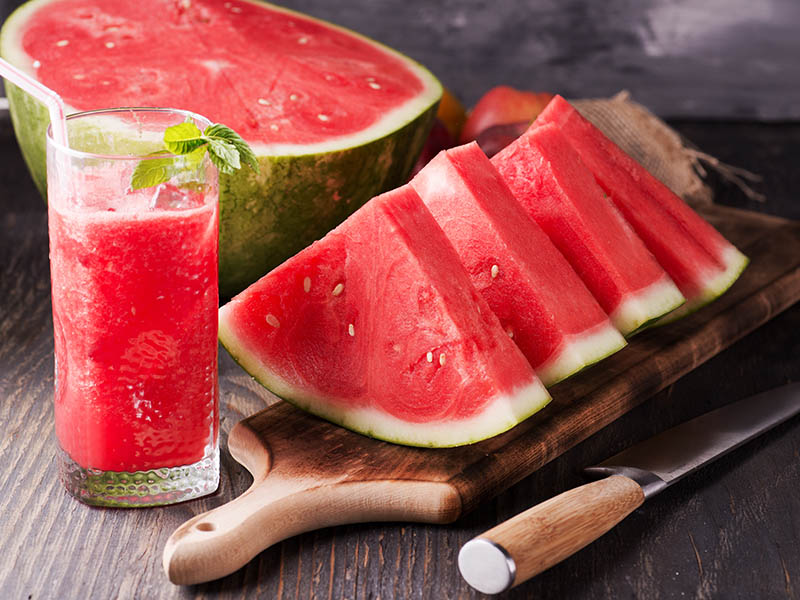
It is a fantastic experience when consuming fresh and juicy watermelon in the summer in Haiti. This excellent fruit is a characteristic member of the Cucurbitaceae family. You can see about 1000 different types of watermelon worldwide.
Watermelon was cultivated first in the Dead Sea region in ancient times. This excellent fruit appeared in Haiti and the Americas in the 16 century, and Spanish settlers brought it to this continent.
It is an extensive fruit covered by a thick rind. The skin is often green and has many stripes on the surface. Usually, Haitians will take advantage of the red, pink, orange, or yellow flesh for desserts. There are countless tiny seeds inside.
It is incredible to enjoy succulent and sweet watermelon on summer days. Also, it is a good option for making juice because of the high water content. The delicate flavor is compatible to add to ice cream, cake, and many other sweet desserts.
Nutrients: Rich in calories, carbs, vitamin C, potassium, and magnesium.
Season: Summer is the best time for harvesting watermelon in Haiti.
How to eat: You can eat the juicy and sweet flesh with a spoon after cutting it into 2 sections.
7. Soursop – Kowosol
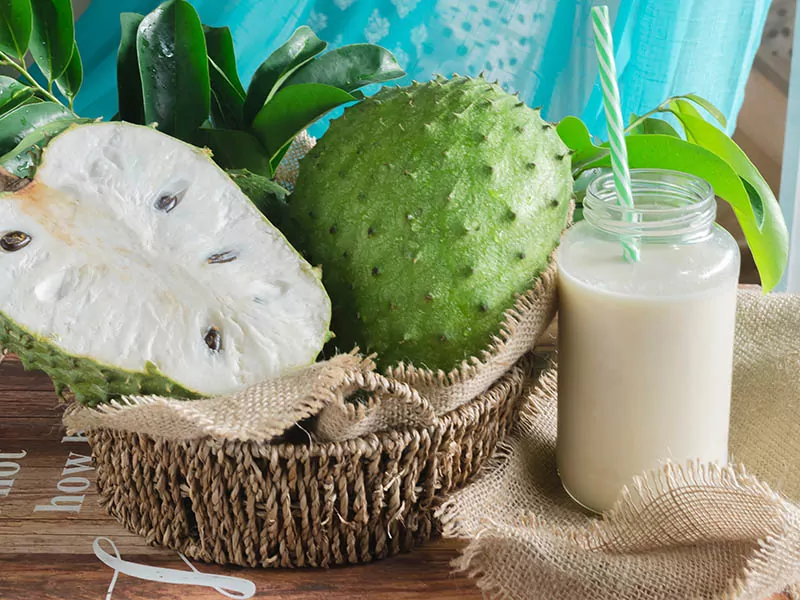
Haitians consider soursop or Kowosol the staple fruit in the summer. It is a well-known and iconic fruit in the regions of the Caribbean and the Americas. Peru, Brazil, Guatemala, and Haiti are the leading producers of soursop in the Americas.
Also, this fruit is cultivated widely in many countries in Southeast Asia. This fruit looks prominent in the deep green and prickly skin. There are numerous thorns on the skin’s surface. It often appears oval and has a firm texture.
However, the flesh will bring an excellent creamy and soft texture. You will be conquered by the juiciness and appealing aroma of the white meat. It is hard to resist the enchanting sweet flavor of this delicious fruit. Also, a hint of tartness will tickle your taste buds.
This fruit’s perfect taste and creamy texture will mix well with milk to create a delicious dessert. Besides, you will love to eat the raw soursop to get its authentic flavor.
Nutrients: A source of calories, carbs, fiber, vitamin C, magnesium, thiamin, and potassium.
Season: This delicious fruit is common in the summer months in Haiti.
How to eat: Use a knife to dice this fruit into 2 halves and scoop the flesh with a spoon.
8. Tamarind
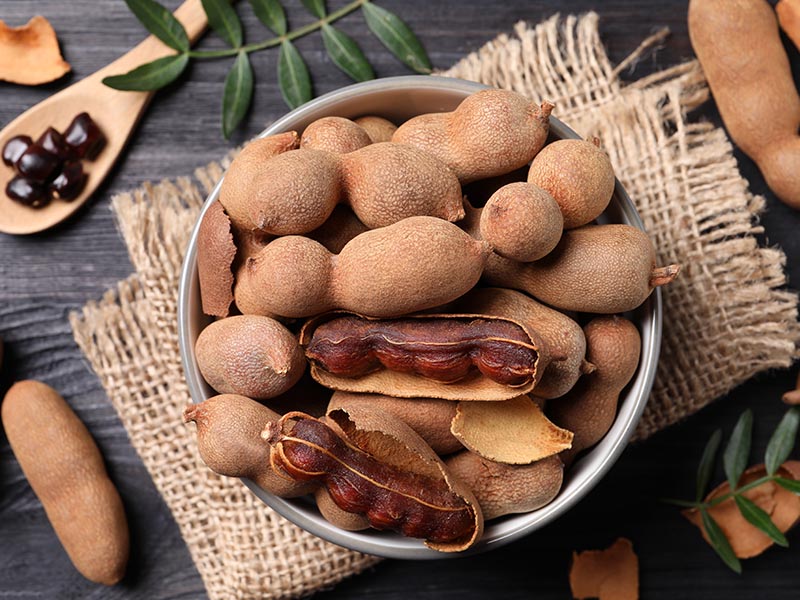
Tamarind is a fantastic suggestion if you love fruit with outstanding tangy flavor. Significantly, almost native Haitians love to use this fruit in cuisine. It is a common ingredient in many excellent Haitian foods. Tamarind belongs to the Fabaceae family.
Although this fruit is indigenous in Africa, it is popular in Haiti, the Americas, and many parts of the world. It was introduced in Central America in the 16th century. India is the primary tamarind producer globally.
The flesh of tamarind is covered in a pod with hard and brown skin. Its delicious flesh will turn brown or reddish-brown when ripe. It contains about 6 to 12 seeds inside, and you cannot consume these seeds.
The sweet flavor of ripe tamarind will make the Haitian recipes better and more attractive. Moreover, the appearance of sourness will bring a characteristic feature to the dishes. There are no problems when consuming raw tamarind.
This fruit often appears in Haiti’s excellent curries, chutneys, and syrups. Furthermore, you can combine it with meat dishes or stews to create unique foods.
Nutrients: High in vitamin C, potassium, phosphorus, calories, carbs, and fiber.
Season: The peak season is between spring and autumn.
How to eat: Remove the skin with your fingers. Eat the flesh around the seeds and remove them.
Listen to the fantastic information about excellent tamarind.
9. Banana
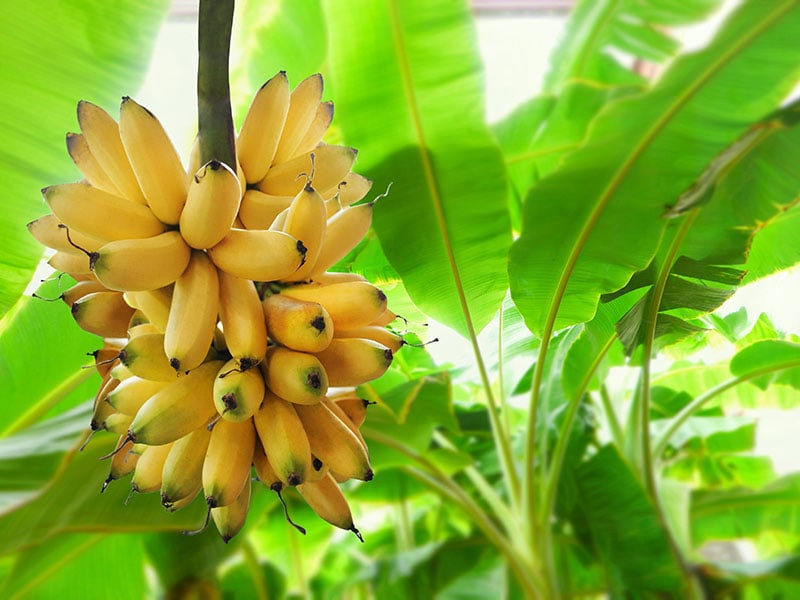
Banana is a global fruit, so finding this fruit in Haiti is not complicated. Thanks to the delicate and moderate flavor, it is an ideal choice to make ice cream, cakes, smoothies, wine, beer, and other desserts. Fried banana is a delicious snack you should not miss.
Banana cultivation took place for the first time in New Guinea. Gradually, it spreads to Southeast Asia, South Asia, East Africa, and many other areas worldwide. Plantain is a kind of green banana that is often used in cooking.
There are many different types of bananas in various sizes and colors. Typically, it is often in an elongated shape. Unripe bananas will be firm and are protected by green and soft skin. The yellow, purple, or red shades will appear when ripe.
You will immerse yourself in the creamy texture and wonderful sweetness of the white flesh. Also, a bit of sourness will leave a profound impression on your mind. The flavor tastes like a mixture of pineapple, melon, and clove.
Nutrients: Plenty of calories, protein, carbs, fiber, and vitamin C.
Season: You can buy this fruit all year round in Haiti.
How to eat: Peel the soft skin of this fruit and consume the creamy flesh directly.
10. Breadfruit – Lamveritab
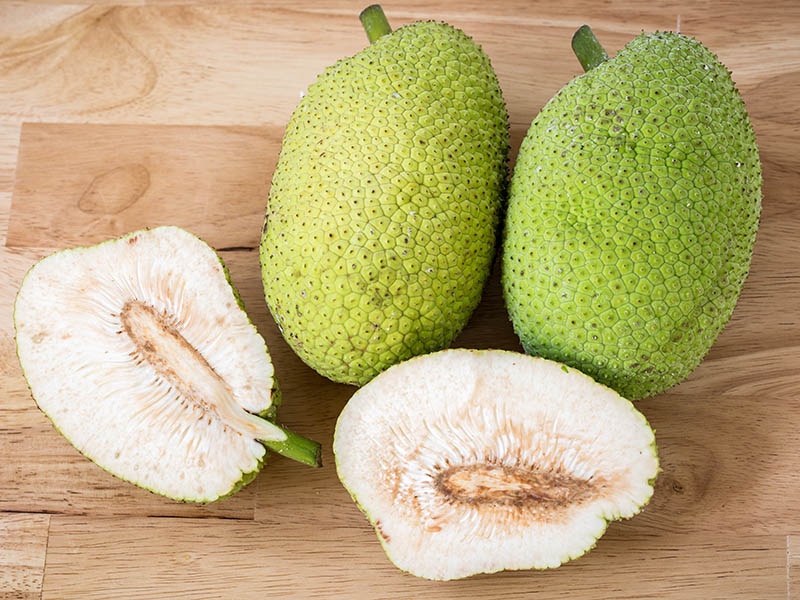
If you are searching for a yummy Haitian dessert, breadfruit or lamveritab is a perfect suggestion you should consult. It has the same family as mulberry and jackfruit. This fruit is native to New Guinea, the Philippines, and the Maluku Islands.
The seedless version of this fruit was introduced in the Caribbean in the 18th century. Today, its cultivation happens widely in Southeast and South Asia, Africa, and Central America. Its name comes from the similarities between its texture and baked bread.
This fantastic fruit looks like a jackfruit in appearance. The round, oblong, or oval are the common forms of this fruit. It includes a thick green peel with countless small pimples around the skin like jackfruit.
Unlike jackfruit, this excellent fruit has white flesh and a mild flavor. Its taste resembles the flavor of potatoes. You can find the intense sweetness in riper breadfruit. Besides the seedless version, you can consume the seeds of the seeded one.
This fruit is compatible for baking, roasting, boiling, and frying to create many excellent treats. Furthermore, people often add coconut milk and cooked breadfruit in banana leaves to bake.
Nutrients: Rich in calories, sodium, carbs, fiber, protein, and potassium.
Season: Its season lasts from July to February in this country.
How to eat: Use your hand or a knife to break the fruit and eat the flesh with a spoon.
Expand your knowledge with all helpful information about breadfruit.
11. Star Apple – Pied Caimite
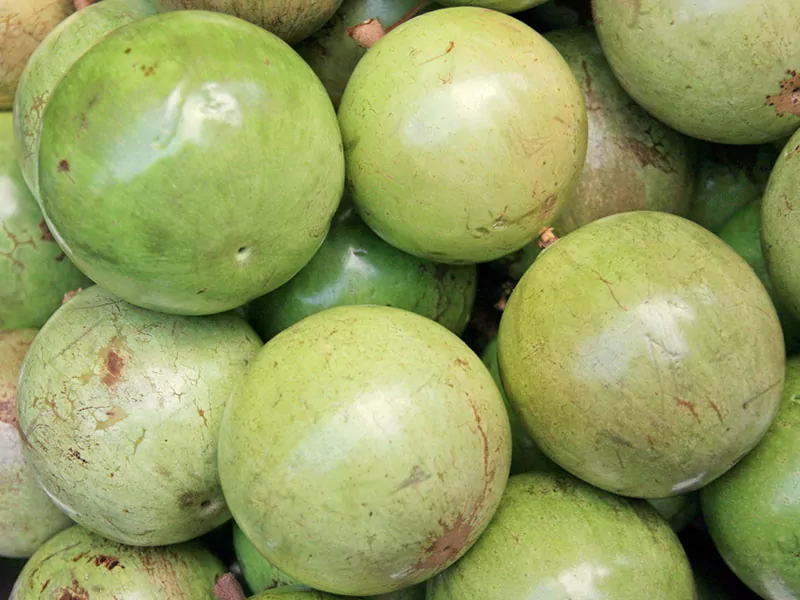
Star apple belongs to the Sapotaceae family and originates in the Isthmus of Panama. It spread to the West Indies, Haiti, and Southeast Asia, the Greater Antilles, and became famous in these areas. Also, it is an iconic Vietnamese fruit with the name “Vu Sua”.
This fruit has many other names, such as tar apple, purple star apple, milk fruit, or aguay. You will love to touch the smooth texture of purple, yellow, or greenish-brown skin. Moreover, you can see some green spots on the surface. Occasionally, it has a green peel.
It is difficult to peel the skin of the purple version because it is thick. If you love the juicy flesh, you can choose the greenish-brown version. The yellow skin star apple is rare in Haiti.
The sweet and juicy pulp will be a mouthwatering dessert for you after each meal. It is simple to see the star pattern in the pulp. The creamy and soft texture of star apple will fascinate you immediately.
Nutrients: High in fiber, vitamin C, B5, folate, copper, potassium, and magnesium.
Season: It is ripe from late winter to the early summer in Haiti.
How to eat: Take a spoon to eat its flesh after cutting this fruit into 2 parts.
12. Okra – Kalalou
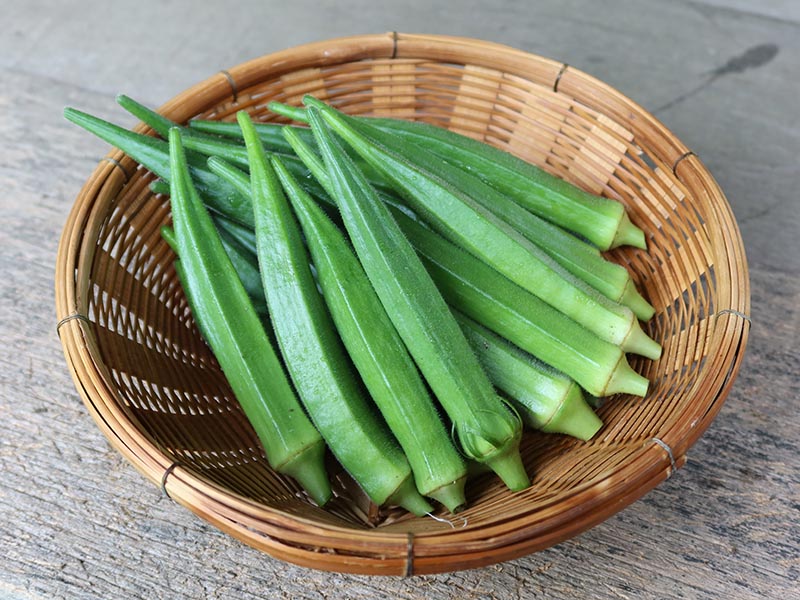
Kalalou or okra plays an essential part in Haitian cuisine when appearing in many fantastic dishes. It belongs to the mallow family and grows widely in tropical and subtropical regions worldwide. This fruit appeared in the Americas in 1658.
This fantastic fruit often grows in length, and okra can length from 4 to 10 inches. There are countless edible and tiny seeds that are protected inside the pod. Typically, you can realize okra quickly, thanks to its green skin.
The mild and grassy flavor of okra is suitable for cooking. You can feel the distinctive taste of this fruit in stews or in some meat recipes. In addition, you can consume it with beans or rice. Of course, you can eat fresh okra if you want.
Nutrients: High in potassium, vitamin B, C, calcium, fiber, and folic acid.
Season: It is available all year round in Haiti.
How to eat: To consume okra, you need to cut an end of this fruit off. You can add it to recipes or eat it raw.
Fall In Love With Amazing Haitian Fruits!
I am sure that you have learned much valuable knowledge after reading this post. This article can help you win the competition related to the list of Haitian fruits in the future. Therefore, please keep them in your mind right now.
You will become a tour guide for many other people by sharing this helpful post if they want to travel to Haiti. Besides, after reading this article, let me know your feelings and opinions via comment. Thanks for your time!
